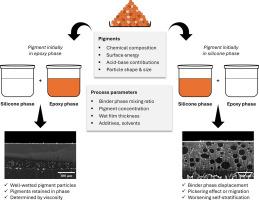颜料在自分层环氧/硅树脂涂料中的作用
IF 7.3
2区 材料科学
Q1 CHEMISTRY, APPLIED
引用次数: 0
摘要
自分层涂料中颜料的集成是实现该技术产业化的关键一步。然而,色素在自分层过程中的作用以及决定其在涂层中定位的参数仍有待充分阐明。本研究系统地研究了环氧/硅基涂料中8种不同颜料对涂层和界面分层和最终分布的影响。研究的关键工艺参数包括:颜料最初分散的粘结剂相(环氧相或硅相)、颜料浓度、粘结剂相混合比和涂膜厚度。进行了颜料和粘合剂相在着色时的流变学测量、截面涂层分析、颗粒表征和表面能研究。颜料,当最初分散到环氧相时,总是保留在这个相中。自分层是由颜料引起的环氧相流变变化所决定的,这种变化随颜料类型和浓度的不同而不同。此外,加入润湿分散添加剂或有机溶剂对膜的形成有积极的影响。相反,当颜料最初被纳入有机硅相时,自分层总体上更差。根据颜料类型的不同,这是由于颜料迁移到环氧相或它们在粘合剂相界面上的吸附。这些意想不到的依赖现象被认为是粘合剂相与颜料颗粒之间的界面相互作用的相互作用,这导致了优先的润湿行为,以及粘合剂相在颜料表面位移的动力学。本文章由计算机程序翻译,如有差异,请以英文原文为准。

The role of pigments in self-stratifying epoxy/silicone coatings
The integration of pigments in self-stratifying coatings represents a critical step towards the industrial realization of this technology. However, the role of pigments in the self-stratification process and the parameters determining their positioning in the coating remain to be fully elucidated. This work systematically studies eight different pigments in an epoxy/silicone-based coating composition for their effects on stratification and final distribution across coating and interfaces. The key processing parameters investigated included: the binder phase in which the pigment was initially dispersed (epoxy or silicone phase), pigment concentration, binder phase mixing ratio, and applied film thickness. Rheological measurements of the binder phases upon pigmentation, cross-sectional coating analyses, particle characterization and surface energy studies of the pigments and binder phases were conducted.
Pigments, when originally dispersed into the epoxy phase, were always retained in this phase. Self-stratification was strongly determined by pigment-induced rheological changes of the epoxy phase, which varied with pigment type and concentration. Moreover, the addition of wetting and dispersing additives or organic solvents exhibited a positive effect on film formation. Conversely, self-stratification was worse overall when pigments were initially incorporated into the silicone phase. Depending on the pigment type, this was due to migration of pigments to the epoxy phase or their adsorption at the interface of the binder phases. These unexpected dependent phenomena are concluded to be an interplay between interfacial interactions between the binder phases and the pigment particles, which lead to preferential wetting behavior, and the kinetics of the binder phase displacement at the pigment surface.
求助全文
通过发布文献求助,成功后即可免费获取论文全文。
去求助
来源期刊

Progress in Organic Coatings
工程技术-材料科学:膜
CiteScore
11.40
自引率
15.20%
发文量
577
审稿时长
48 days
期刊介绍:
The aim of this international journal is to analyse and publicise the progress and current state of knowledge in the field of organic coatings and related materials. The Editors and the Editorial Board members will solicit both review and research papers from academic and industrial scientists who are actively engaged in research and development or, in the case of review papers, have extensive experience in the subject to be reviewed. Unsolicited manuscripts will be accepted if they meet the journal''s requirements. The journal publishes papers dealing with such subjects as:
• Chemical, physical and technological properties of organic coatings and related materials
• Problems and methods of preparation, manufacture and application of these materials
• Performance, testing and analysis.
 求助内容:
求助内容: 应助结果提醒方式:
应助结果提醒方式:


